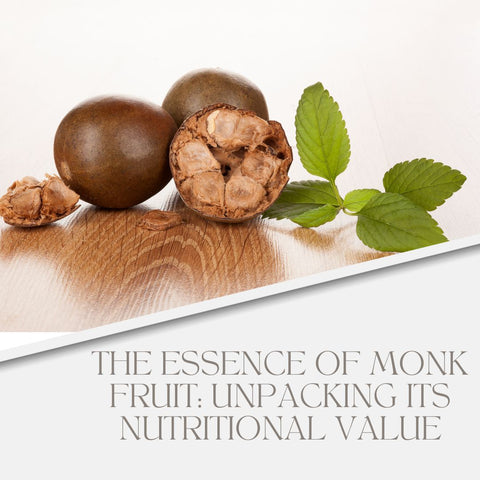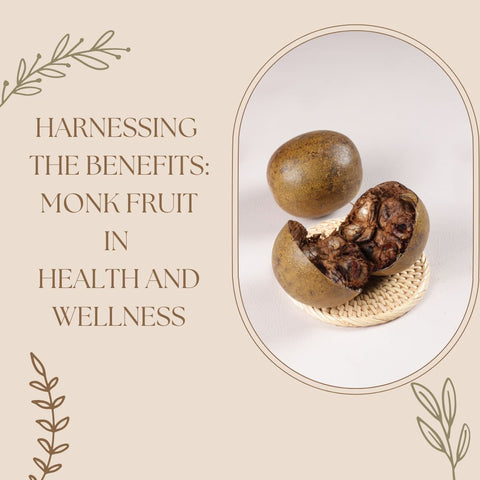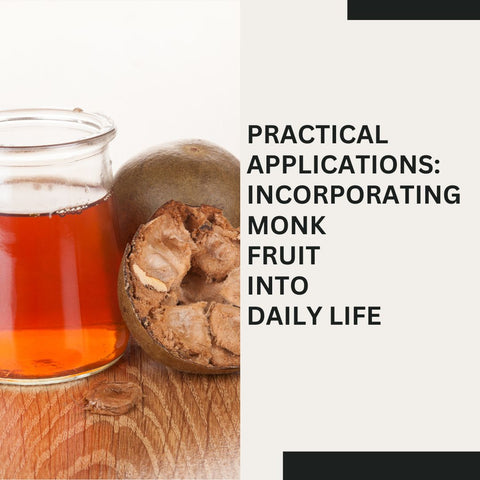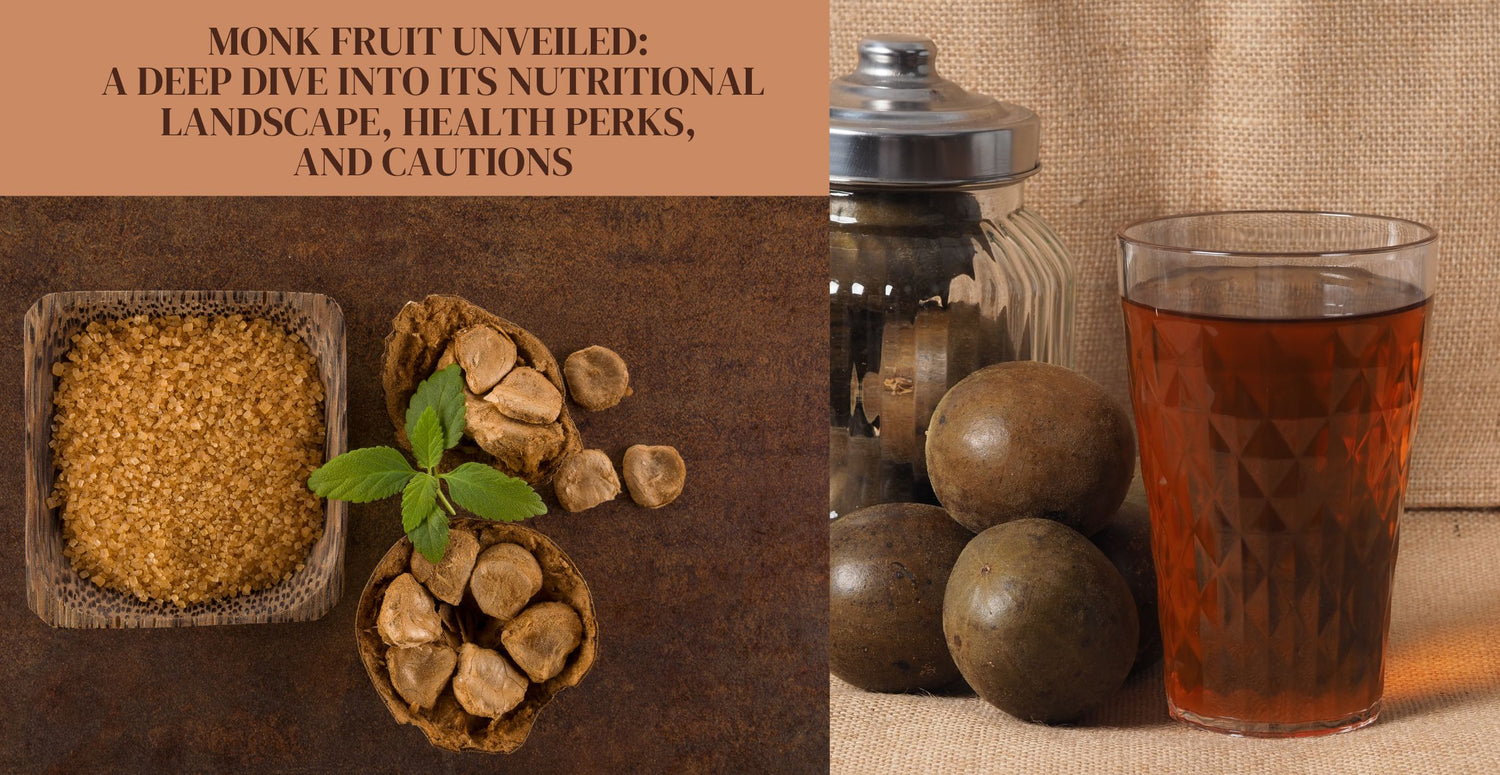Monk fruit, also called Luo Han Guo or Siraitia grosvenorii, is a small green gourd native to southern China and northern Thailand. For centuries, it has been used in Traditional Chinese Medicine as a natural sweetener with purported health benefits. Monk fruit has recently gained popularity as a sugar substitute due to its intense sweetness and low impact on blood sugar levels. In this blog, we will look at the nutritional landscape, health benefits, and precautions.
The Essence of Monk Fruit: Unpacking Its Nutritional Value

Monk fruit is more than just a sweetener; it is a natural substitute for sugar that contains almost no calories and has little effect on blood sugar levels. Its antioxidant properties and potential health benefits make it a popular choice for those looking to reduce their sugar intake while still enjoying sweetness. Including monk fruit sweeteners in your diet can be a simple but effective way to improve overall health and wellness.
Exploring the Sweetness: How Monk Fruit Compares to Sugar
Monk fruit sweeteners are a natural, calorie-free alternative to sugar that provides intense sweetness with little impact on blood sugar levels. Individuals who replace sugar with monk fruit sweeteners can enjoy sweet-tasting foods and beverages without adding calories or negatively impacting dental and metabolic health.
Key Nutrients and Antioxidant Profile of Monk Fruit
Monk fruit, or Luo Han Guo, is a small green gourd native to southern China and northern Thailand. While monk fruit is primarily known for its intense sweetness, it also contains some key nutrients and has antioxidant properties.
Key Nutrients:
-
Monk fruit contains very few essential vitamins and minerals. It contains very few nutrients in comparison to its sweetening compounds.
-
Monk fruit contains trace amounts of natural sugars and fibres, but the exact composition varies depending on the type of monk fruit used.
Antioxidant Profile:
-
The primary active compounds in monk fruit that cause its intense sweetness are mogrosides. These mogrosides also have antioxidant properties, which help to neutralise free radicals and reduce oxidative stress.
-
Monk fruit extract, specifically the mogroside compounds, has been shown in studies to have antioxidant properties. Antioxidants are essential for protecting cells from free radical damage, which can cause oxidative stress and inflammation.
-
The antioxidant properties of monk fruit may contribute to a variety of health benefits, including a lower risk of chronic diseases like heart disease, diabetes, and certain cancers. However, more research is needed to fully understand the extent of these benefits and their mechanisms of action.
Understanding the Low-Calorie Appeal of Monk Fruit Sweeteners
Monk fruit sweeteners are a low-calorie alternative to sugar that maintains sweetness. Their intense sweetness is derived from mogrosides, which are not metabolised for energy and have little effect on blood sugar levels. Monk fruit sweeteners can help people reduce calorie intake, manage blood sugar levels, and improve overall health and wellness, making them a popular choice for those looking for healthier sweetening options.
Harnessing the Benefits: Monk Fruit in Health and Wellness

Monk fruit has several potential health and wellness benefits, making it a popular choice among those seeking natural alternatives to sugar and artificial sweeteners. Here's how to use monk fruit for its benefits:
-
Low Glycemic Index: Monk fruit sweeteners have a negligible effect on blood sugar levels due to their lack of digestible carbohydrates. Using monk fruit sweeteners as a sugar substitute can help people manage their blood sugar levels, making them appropriate for diabetics or those on low-carb diets.
-
Calorie-Free Sweetening: Monk fruit sweeteners provide sweetness without the added calories from sugar. Substituting monk fruit sweeteners for sugar can help reduce overall calorie intake, making it easier to maintain a healthy weight and support weight loss goals.
-
Mogrosides: The mogroside compounds in monk fruit are antioxidants, which help to neutralise free radicals and reduce oxidative stress in the body. Antioxidants protect cells from damage and may improve overall health and longevity.
-
Non-Cariogenic: Monk fruit sweeteners do not promote tooth decay because they are not fermentable by oral bacteria. Using monk fruit sweeteners instead of sugar can help prevent cavities and tooth decay.
-
No Artificial Ingredients: Monk fruit sweeteners are made from natural fruit extract and contain no artificial additives or preservatives. Choosing monk fruit sweeteners over artificial sweeteners can provide sweetness while avoiding the health risks associated with artificial ingredients.
-
Keto-Friendly and Vegan: Monk fruit sweeteners are suitable for a variety of dietary styles, including keto, vegan, and gluten-free. They provide a versatile sweetening option for those with dietary restrictions or preferences.
-
Enhanced Flavour: Monk fruit sweeteners can improve the flavour of foods and beverages without the unpleasant aftertaste associated with some artificial sweeteners. Their natural sweetness can make healthy eating more appealing and sustainable.
Diabetes Management: The Role of Monk Fruit in Blood Sugar Control
Monk fruit can play a beneficial role in diabetes management due to its unique properties that contribute to blood glucose control:
-
Negligible Impact on Blood Sugar Levels: Monk fruit sweeteners have a low glycemic index, which means they cause only minor fluctuations in blood glucose levels after consumption. Unlike sugar, which quickly raises blood sugar levels, monk fruit sweeteners provide sweetness without causing a blood sugar spike.
-
Alternative to High-Glycemic Sweeteners: Individuals with diabetes often need to monitor their carbohydrate intake and manage blood sugar levels. Monk fruit sweeteners offer a natural, calorie-free alternative to high-glycemic sweeteners like sugar and honey, allowing individuals with diabetes to satisfy their sweet cravings without negatively impacting blood glucose levels.
-
Potential for Improving Insulin Sensitivity: While more research is needed, some studies indicate that the antioxidants found in monk fruit may improve insulin sensitivity and glucose metabolism. Monk fruit may help improve insulin sensitivity, which is necessary for controlling blood sugar levels in diabetes, by reducing oxidative stress and inflammation.
-
Support for Weight Loss and Maintenance: Obesity and overweight are risk factors for type 2 diabetes. Monk fruit sweeteners provide sweetness without the added calories of sugar, making them an effective tool for diabetics looking to control their weight. Monk fruit sweeteners can help diabetics lose and keep weight off by lowering calorie intake and increasing satiety.
-
Non-Cariogenic: Monk fruit sweeteners do not promote tooth decay since they are not fermentable by oral bacteria. Choosing monk fruit sweeteners over sugar can help diabetics maintain good dental health by lowering the risk of cavities and tooth decay, which can be exacerbated by high blood sugar levels.
Aiding Weight Loss: How Monk Fruit Fits into a Healthy Diet
Incorporating monk fruit sweeteners into your diet can help you lose weight by lowering calorie and sugar intake, stabilising blood sugar levels, curbing sugar cravings, and increasing overall dietary satisfaction. Whether you're sweetening your morning coffee, baking healthy treats, or preparing savoury meals, monk fruit sweeteners are a natural and versatile way to reduce added sugars and calories while still enjoying your favourite flavours. Monk fruit, when combined with a well-balanced diet and an active lifestyle, can be an effective tool for achieving and maintaining good health.
Skin Health and Monk Fruit: Investigating the Beauty Connection
While monk fruit is best known as a natural sweetener, there is growing interest in its potential skin-health and beauty benefits. Here's how monk fruit might be related to skincare:
-
Antioxidant Properties: Monk fruit contains mogrosides, which are antioxidants. Free radicals, environmental pollutants, and UV radiation all cause oxidative stress in the skin, which antioxidants help protect against. Antioxidants in skincare products can help reduce signs of ageing like wrinkles, fine lines, and age spots.
-
Anti-Inflammatory Effects: According to some research, mogrosides may have anti-inflammatory properties that can help to relieve skin irritation, redness, and inflammation. This can be especially beneficial for people who have sensitive or acne-prone skin.
-
Hydration and Moisture: Monk fruit extract has humectant properties, which means it attracts and holds moisture in the skin. Using skincare products containing monk fruit extract can help hydrate the skin, leaving it feeling soft, smooth, and supple.
-
Potential for Collagen Production: While more research is needed, some studies suggest that monk fruit may help with collagen synthesis, the protein responsible for skin elasticity and firmness. By promoting collagen production, monk fruit extract may help improve skin texture and reduce the appearance of wrinkles and sagging skin.
-
Natural Ingredient: Monk fruit extract is derived from the fruit and is suitable for all skin types, including sensitive skin. It is less likely to cause irritation or allergic reactions than synthetic or harsh chemical ingredients commonly used in skincare products.
-
Incorporation into Skincare Products: Monk fruit extract is found in a variety of skincare products such as serums, moisturisers, masks, and creams. Look for products containing monk fruit extract or its derivatives to reap the potential benefits for skin health and beauty.
Navigating the Considerations: The Other Side of Monk Fruit

While monk fruit is generally considered safe and has several potential health benefits, there are some factors to consider, particularly its use as a sweetener and potential side effects:
-
Effect on Blood Sugar Levels: Monk fruit extract is a natural sweetener containing compounds known as mogrosides, which are not metabolised by the body and do not contribute calories or carbohydrates. As a result, monk fruit sweeteners have little effect on blood sugar levels and may be an appropriate option for people with diabetes or those on a low-carbohydrate diet.
-
Gastrointestinal Distress: In some people, consuming large amounts of monk fruit sweetener or products containing monk fruit extract can cause gastrointestinal distress, such as bloating, gas, or diarrhoea. This is primarily due to the high concentration of mogrosides, which can cause laxative effects in some people, particularly when consumed in excess.
-
Allergic Reactions: Although uncommon, allergic reactions to monk fruit have been reported in some people. Itching, swelling, hives, and difficulty breathing are all possible symptoms of an allergic reaction. If you suspect you are allergic to monk fruit, stop using it and seek medical attention.
-
Potential Additives: Some commercially available monk fruit sweeteners may contain additives or fillers to improve flavour, texture, or stability. It is critical to carefully read ingredient labels, especially if you have food sensitivities or allergies, to ensure that the product is pure monk fruit extract with no additional ingredients.
-
Interactions with medications: When consumed in moderation as a sweetener, monk fruit is generally thought to be safe. However, if you have any underlying health conditions or are taking medications, you should consult a healthcare professional before adding monk fruit to your diet, as it may interact with certain medications or treatments.
-
Quality and Purity: When purchasing monk fruit sweeteners or products containing monk fruit extract, look for reputable brands that value quality and purity. Look for certified organic products that are free of additives, preservatives, and artificial ingredients.
Potential Side Effects and Allergic Reactions to Monk Fruit
While monk fruit is generally considered safe for most people, there are some potential side effects and allergic reactions to be aware of:
-
Allergic Reactions: Allergic reactions to monk fruit are uncommon but do occur in some people. Symptoms of an allergic reaction include itching, hives, swelling of the face or tongue, difficulty breathing, and, in severe cases, anaphylactic shock. Consult a Healthcare Professional: If you develop any allergic symptoms after consuming monk fruit products, seek medical attention right away.
-
Gastrointestinal Issues: Some people may experience gastrointestinal issues such as bloating, gas, diarrhoea, or stomach cramps after consuming monk fruit sweeteners, especially in large quantities. Individual Sensitivity: Sensitivity to sugar alcohols or other ingredients commonly found in monk fruit sweeteners may contribute to digestive discomfort in some people.
-
Interaction with Medications: Limited research has been conducted on the potential interactions between monk fruit and medications. If you are taking medications or have any underlying health conditions, speak with a doctor before consuming monk fruit products to ensure there are no negative interactions.
-
Other Considerations: While monk fruit sweeteners are generally considered safe during pregnancy and breastfeeding, it is always a good idea to consult with a healthcare professional before introducing new foods or ingredients into your diet. Monk fruit sweeteners are not recommended for infants under six months old. Moderation is key for older children, and any adverse reactions must be monitored closely.
The Dos and Don’ts: Safely Incorporating Monk Fruit into Your Diet
Incorporating monk fruit into your diet can help you cut sugar while still enjoying sweet flavours. Here are some dos and don'ts for safely including monk fruit in your diet:
Dos:
-
When purchasing monk fruit sweeteners or monk fruit-containing products, carefully read the ingredient labels to ensure that they contain pure monk fruit extract with no added sugars or artificial ingredients.
-
If you are new to monk fruit sweeteners, start small and gradually increase as needed. This can help you adjust to the taste and reduce the likelihood of digestive discomfort.
-
While monk fruit sweeteners are calorie-free, they should be consumed in moderation as part of a well-balanced diet. Excessive consumption may cause gastrointestinal issues in some people.
-
Monk fruit sweeteners can be used in a wide range of recipes, including drinks, baked goods, sauces, and dressings. Experiment with different recipes to discover tasty ways to incorporate monk fruit into your favourite dishes.
-
Monk fruit sweeteners can be combined with other natural sweeteners such as stevia or erythritol to balance sweetness and enhance flavour profiles in recipes.
Don'ts:
-
Not all monk fruit sweeteners are created equally. Some products may contain added sugars, fillers, or artificial ingredients, reducing the health benefits of monk fruit. Always check the ingredient list before making a purchase.
-
While monk fruit sweeteners are generally safe for most people, excessive consumption may cause digestive discomfort. Stick to recommended serving sizes and listen to your body's signals.
-
Monk fruit sweeteners should be used in conjunction with a nutritious diet that includes fruits, vegetables, whole grains, and lean proteins. Do not rely solely on monk fruit sweeteners to meet your nutritional requirements.
-
When using monk fruit sweeteners, make sure to stay hydrated by drinking plenty of water throughout the day. Hydration promotes overall health and can help prevent potential digestive issues caused by sweeteners.
-
Everyone's tolerance for monk fruit sweeteners may differ. Pay attention to how your body reacts, and adjust your intake accordingly. If you have any adverse reactions, stop using it and see a doctor.
Understanding the Sustainability of Monk Fruit Cultivation
Understanding the sustainability of monk fruit cultivation requires taking into account a variety of factors, including environmental impact, agricultural practices, social considerations, and economic viability. This is an overview:
Environmental Impact:
-
Monk fruit is typically grown in China's mountainous regions, where it thrives in relatively undisturbed conditions. Sustainable cultivation practices seek to reduce deforestation and habitat destruction to preserve biodiversity.
-
Monk fruit cultivation frequently relies on traditional farming methods that use few chemical inputs, such as pesticides and fertilisers. Organic farming practices help to reduce environmental impact by avoiding synthetic chemicals.
-
Monk fruit is drought-tolerant and requires less water than most other crops. To reduce water consumption, sustainable cultivation practices prioritise water conservation, efficient irrigation, and rainwater harvesting.
Agricultural Practices:
-
Crop rotation and soil conservation are examples of sustainable monk fruit cultivation practices that help to preserve soil fertility, prevent erosion, and reduce nutrient depletion.
-
Instead of relying solely on pesticides, sustainable farmers can use integrated pest management techniques like biological control and companion planting to manage pests while minimising environmental impact.
-
To promote biodiversity and ecosystem resilience, sustainable farms may use agroforestry practices, intercropping, and natural habitat preservation techniques.
Social Considerations:
-
Ethical monk fruit cultivation prioritises fair labour practices, such as safe working conditions, fair wages, and access to healthcare and education for workers and their families.
-
Sustainable farming initiatives frequently involve working with local communities to promote economic development, cultural preservation, and social well-being.
-
Ensuring land tenure rights for local communities and indigenous peoples is critical for preventing land grabs and promoting equitable resource access.
Economic Viability:
-
Sustainable monk fruit cultivation necessitates access to fair and transparent markets that offer farmers stable prices and opportunities for value-added processing and marketing.
-
Continued investment in R&D can lead to innovations in cultivation techniques, product diversification, and market expansion, thereby increasing the economic viability of monk fruit farming.
-
Certification schemes, such as organic and fair trade certification, can reassure consumers and buyers that monk fruit products are produced sustainably and ethically.
Practical Applications: Incorporating Monk Fruit into Daily Life

Incorporating monk fruit into your daily routine can be simple and versatile. Practical applications include sweetening beverages, baking and cooking, breakfast, snacks and desserts, beverages and cocktails, sauces and marinades, salad dressings, frozen treats, and on-the-go snacks. Monk fruit sweetener can be used in a variety of daily recipes and meals, including beverages, breakfast, snacks, and desserts. Experiment with different applications to find delicious and nutritious ways to incorporate the natural sweetness of monk fruit into your daily life.
Creative Ways to Use Monk Fruit in Cooking and Baking
Monk fruit is a versatile ingredient for cooking and baking, providing sweetness without the added calories of sugar. Here are some innovative ways to use monk fruit in your culinary adventures:
Cooking:
-
Use monk fruit to sweeten your stir-fry sauces and balance the flavours. It provides a hint of sweetness that complements savoury dishes.
-
Use monk fruit sweetener to marinate meats, tofu, or vegetables before grilling or roasting. It caramelises beautifully and provides depth to the dish.
-
To achieve an Asian-inspired flavour profile, blend soy sauce, ginger, garlic, and monk fruit sweetener to create glazes for meats like chicken or salmon..
-
Incorporate monk fruit into homemade sauces like barbecue sauce or teriyaki sauce for a healthier alternative to store-bought versions.
Baking:
-
Substitute sugar with monk fruit sweetener in cookie recipes. It provides the sweetness needed without the added calories.
-
Use monk fruit sweetener in cake and cupcake batters to achieve a moist and sweet result. Pair it with your favorite frosting for a guilt-free dessert.
-
Add monk fruit sweetener to muffin and quick bread recipes for a delicious breakfast or snack option.
-
Use monk fruit sweetener in fruit pie fillings or tart fillings for a naturally sweetened dessert. It pairs well with fruits like berries, apples, and peaches.
Beverages:
-
Sweeten your smoothies with monk fruit sweetener instead of sugar or honey. It blends seamlessly with fruits, greens, and other ingredients.
-
Stir monk fruit sweetener into iced tea or lemonade for a refreshing and naturally sweetened beverage.
-
Create low-calorie cocktails by using monk fruit sweetener as a substitute for simple syrup in drinks like mojitos, margaritas, and daiquiris.
Miscellaneous:
-
Use monk fruit sweetener to sweeten homemade granola. It adds a touch of sweetness without the added sugars found in store-bought versions.
-
Incorporate monk fruit sweetener into homemade salad dressings for a sweet and tangy flavor profile.
-
Sweeten chia seed pudding with monk fruit sweetener for a healthy and satisfying dessert or snack option.
Finding and Choosing Monk Fruit Products: A Buyer’s Guide
Finding and selecting monk fruit products can be straightforward with the right approach. Here's a buyer's guide to help you get started: Check ingredient labels, consider product form, look for certifications, research brands, compare prices, look for allergen information, consider packaging, and read reviews and recommendations. By following this buyer's guide, you can find and choose monk fruit products that meet your needs and preferences. Whether you're sweetening drinks, baking, or cooking, using high-quality monk fruit products gives you the confidence to enjoy monk fruit's natural sweetness.
The Future Outlook: Monk Fruit’s Place in the Health and Wellness Industry
Monk fruit is expected to play an important role in the health and wellness industry, owing to increased consumer demand for natural, low-calorie sweeteners. With continued research, innovation, and market expansion, monk fruit is expected to gain popularity as a healthier alternative to sugar and artificial sweeteners. Monk Fruit's position in the health and wellness industry is expected to improve in the coming years as more people become aware of its benefits and product offerings expand.
Empowered Choices: Integrating Monk Fruit for Optimal Health

Integrating monk fruit into your diet can help you achieve optimal health by providing sweetness without the negative effects of sugar. Here are some tips for making empowered choices when incorporating monk fruit: Replace sugar with monk fruit, read labels and choose wisely, practise moderation, combine with nutrient-rich foods, stay hydrated, consider individual needs, and enjoy the journey. By making empowered choices and incorporating monk fruit into your diet in mindful and balanced ways, you can enjoy its sweetness while also benefiting your overall health and well-being. Whether you're looking to cut back on sugar, lose weight, or simply enjoy healthier options, monk fruit can be a valuable ally on your path to better health.















